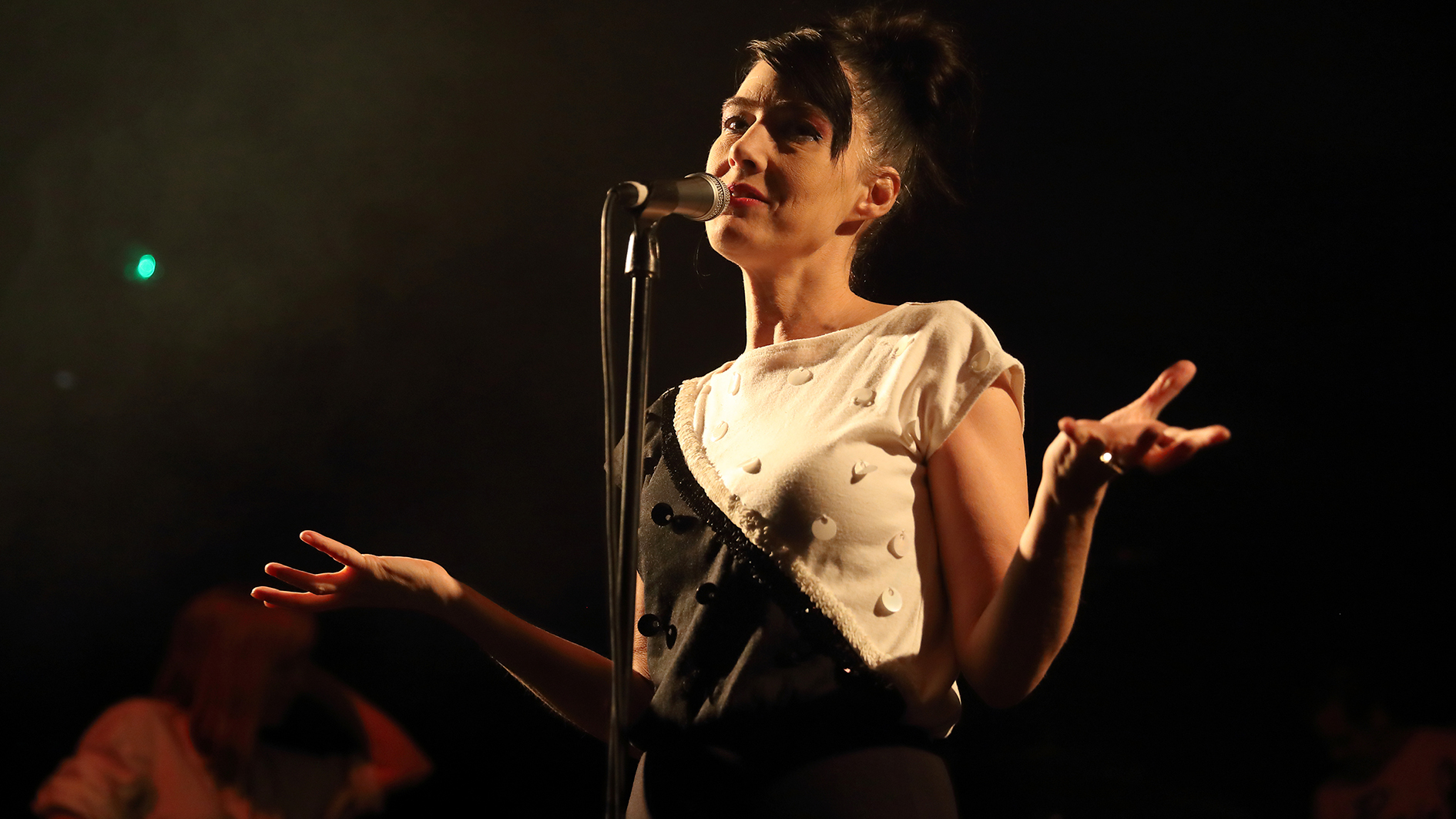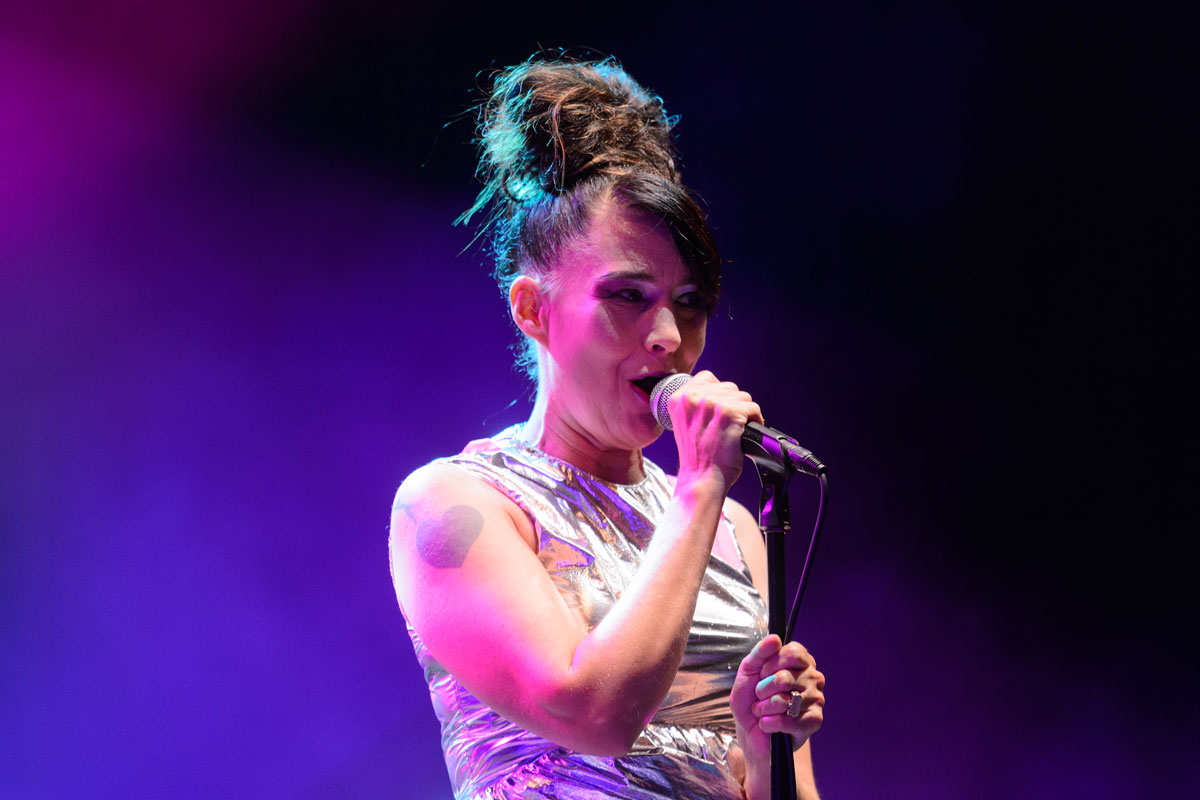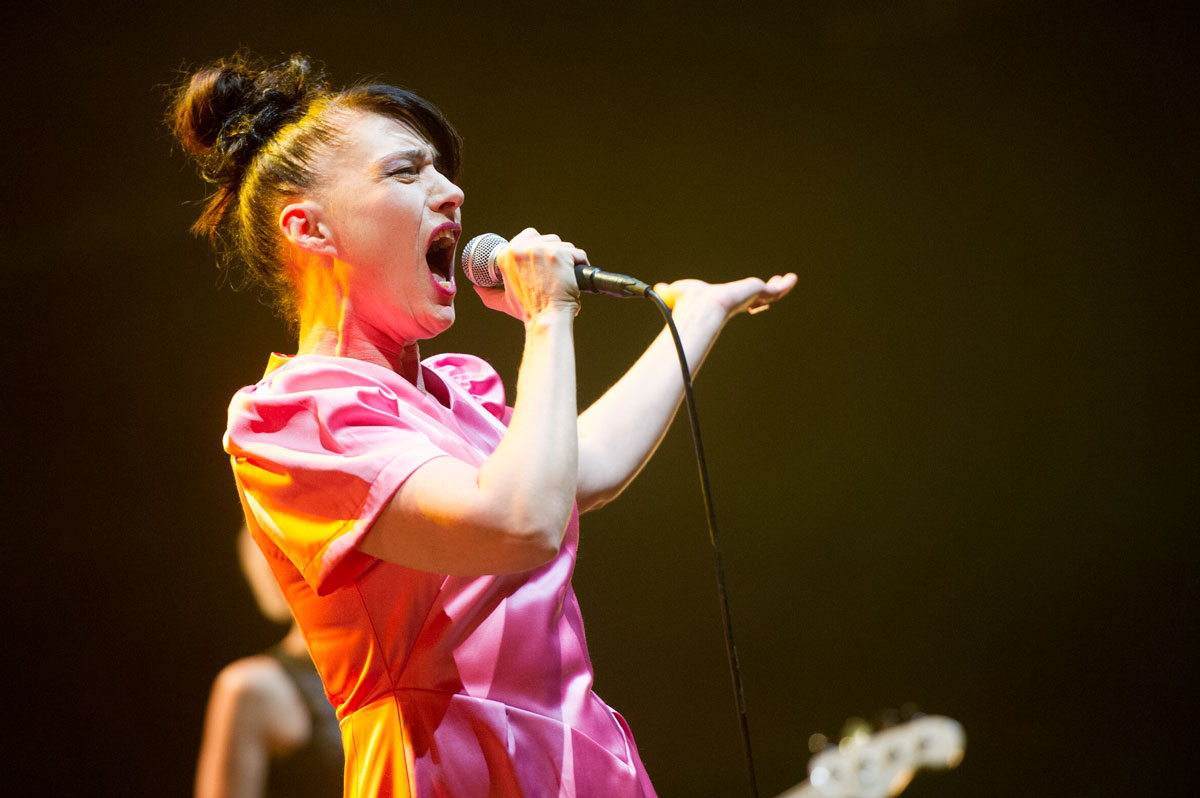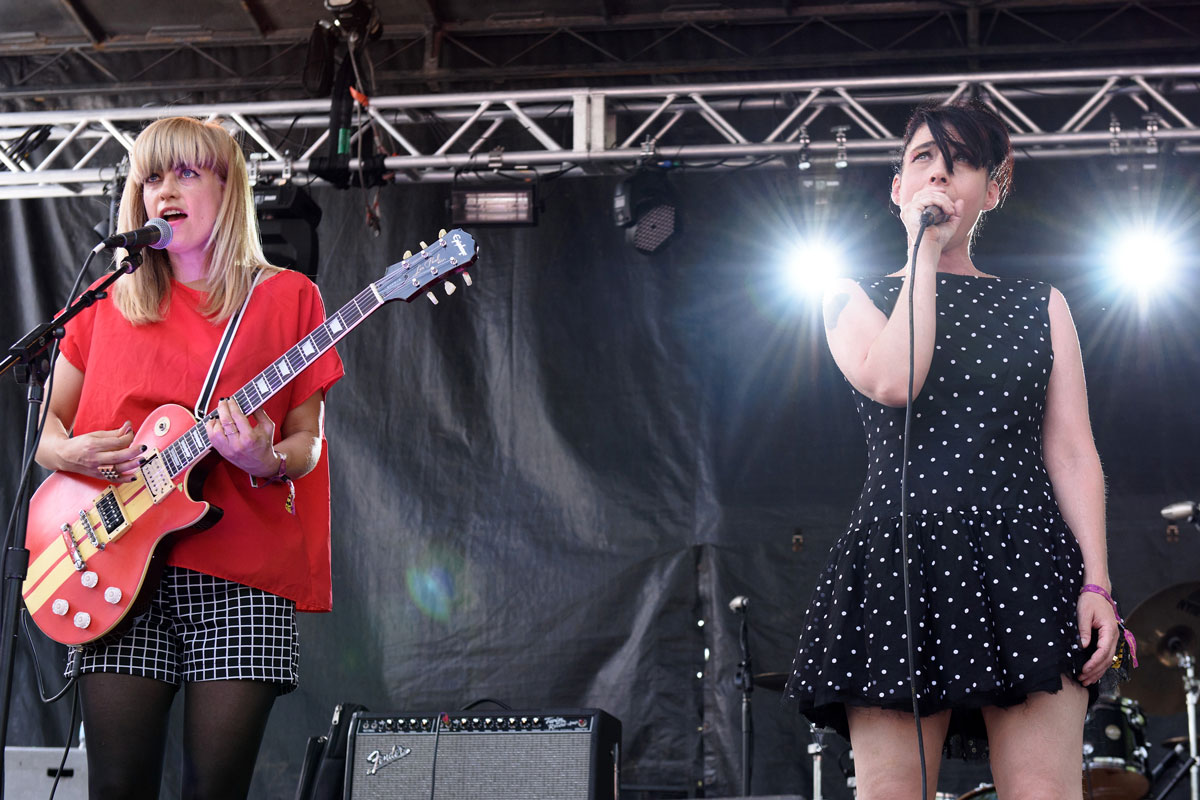Kathleen Hanna: “I love that really sparse guitar sound so much – that’s how I write and that’s what I want to hear”
The punk icon talks working with viral rockers The Linda Lindas, her love of “more amateur-sounding stuff” and why she started a T-shirt business to help send Togolese girls to school

After we talk, famed feminist and political artist, Kathleen Hanna, is off to drop off some T-shirts to The Linda Lindas, the internet’s newest and favorite punk-rock quartet.
Hanna has worked with the band for years, mentoring their burgeoning, significant, youthful project. In a recent viral video, The Linda Lindas were seen wearing t-shirts from Hanna’s Tees4Togo business, which helps to raise awareness and funds for young women in Togo to get their education.
But this work should come as no surprise to fans and followers of Hanna. She’s long dedicated her life to empowering young voices, especially those belonging to young women.
As a result, she’s become known the world over for her music and her politics. Hanna, who is also married to a Beastie Boy, is 20th century rock royalty. Legend has it she came up with the name “Smells Like Teen Spirit”.
We caught up with Hanna to ask her about her history as an artist, how she got involved with Tees4Togo and what’s next for her and her legacy.
When was the first moment you realized the power of art in your life and, perhaps, the power of music or guitar music?
“Oh wow, that’s a big one! I think a huge moment for me when a band that has a guitar player that I love made me be like, ‘Oh, this is important,’ was the first time I saw Fugazi play in the late '80s in Seattle.
Get The Pick Newsletter
All the latest guitar news, interviews, lessons, reviews, deals and more, direct to your inbox!
“That was the first time I ever saw them. They played Suggestion and I’d never heard men singing lyrics about, you know, sexual harassment before.
“But also it sounded amazing! And I love, love, love Ian [MacKaye’s] guitar playing. But Guy Picciotto from Fugazi and Rites of Spring is one of my all time favorite guitar players. For sure. I always call it the ‘heavenly’ guitar style. I don’t mean Heavenly the band. But it sounds like you’re ascending into heaven, or something.”
How and when did you first decide to follow your internal drive? People have instincts but few act on them so fervently – how and when did you start to embrace that side of yourself?
”You know, there are so many different moments. So, it’s more about picking one. Because I know that there’s a lot of times where, you know, I’m like, ‘I’m going to follow the breadcrumbs in my head and I don’t care what anybody else is doing. I’m just going to do this.’
“I mean, I think it really happened when I moved to Olympia when I was 17 years old and I started college. I was surrounded by musicians who were making records on K Records. And I saw kids making culture in a small town.
That was a really big thing, living in a small town with a good local community. It really inspired me to think that I could do whatever I wanted
“That meant rock stars weren’t just Led Zeppelin or Van Halen. They weren’t that far away from me. They were teenagers who went to the same coffee shop I did. That’s how I met Tobi Vail, the drummer for Bikini Kill: she was in a band called the Go Team and I would just see her walking on the street and I’d be like, ‘Oh my god, I love her music and she’s just a normal person.’
“That was a really big thing, living in a small town with a good local community. It really inspired me to think that I could do whatever I wanted. And that there was a lot of female participation.
“Even though there wasn’t that much female participation, even just a tiny bit at that time in the late-'80s, early-'90s was a lot. That K Records supported all different kinds of sounding music, too. You didn’t have to play really heavy guitars to be in a band. It favored the amateur, the more sparse-sounding stuff. That’s what I still like to this day.
“In a way, at the time, people thought of it as more traditionally feminine music. That was something that I think invited a lot of people to be involved and not feel like this is just a straight white guy macho scene. It wasn’t a straight white guy macho scene. It was much more inclusive. So, by example, I saw other people doing whatever they fucking wanted to do. So, I was like, ‘I can too.’”
How did you become aware of the Peace Sisters, when did you know you had to found Tees4Togo in October of 2018 and what has that work brought to you and the world in the past three years?
“I first became aware of Peace Sisters in 2017 when me and my husband [Adam Horovitz of the Beastie Boys] moved to Pasadena to be closer to my mom, because my mom lives here with her partner.
“I was introduced to Tina Kampor, who runs Peace Sisters, by my landlady, the woman who we rent the house from. She was like, ‘Oh, my friend Tina is having this event and this little shop. And it’s about raising money for girls education in Africa.’ And she gave me a flyer. And I was like, ‘That sounds interesting!’

“So, our whole family went. Me and my mom and her partner and Adam, we all went. And then Tina got up and spoke. She was a home-economics teacher in Togo. She grew up in Togo, she’s Togolese-American. And she talked about how she saw all these girls dropping out of school around what we’d consider fourth or fifth grade. A lot of it was because people didn’t have enough money to send their kids. They have to pay tuition for even public school at that age, and it’s $40 a year.
“A lot of the girls just got left by the wayside. Because families were like, ‘If we’re just going to educate one of our kids, we’ll educate the boy.’ Tina was just like, ‘This isn’t right.’
“So, when she moved from Togo and moved to Pasadena, like, 20 years ago, she got a job as a nurse. She works 12 hour days still. She was sending as much money back home as she could to pay for tuition for these girls who were dropping out. She ended up sending hundreds of girls to school just on her salary.
“Then in 2016, she decided to open it up so other people could help her, and she started Peace Sisters. So, I basically went to this little shop and heard her talk and I was like, ‘This is amazing!’ And I said, ‘Hey, can I throw a party for you at our house?’ And she said, ‘Yeah, that’d be great!’
“So, I started throwing parties for Peace Sisters, inviting my friends and trying to get them donations and doing fundraisers for them online on Facebook. I did a thing where I did a bunch of Cameos and I donated the money to them.
During Trump's presidency, he called Africa a ‘shithole nation.’ I was like, ‘What’s the best response? Sell more fucking shirts!’
“I’d already had the idea of doing a T-shirt line for charity. But I was going to do it for a Lyme disease charity. I have chronic Lyme disease but I’m in remission, so I’m doing really well. And I was about to put one out but I said, ‘You know what? I don’t want to have to talk in the press about Lyme disease, my own illness over and over, because it’s going to be traumatic for me.’
“I was like, ‘I just can’t do it!’ But then I thought, ‘I’m already working with Tina. Why don’t I do it for this group that I’m more involved with anyway?’ It became the perfect match and it’s gone great. During COVID, I clung to it! All I wanted to do was work on it. And during Trump['s presidency], he called Africa a ‘shithole nation.’ I was like, ‘What’s the best response? Sell more fucking shirts!’”
I can’t help but think about the work you did as a younger person as you talk about the work you’re doing for Tees4Togo. Are they similar in your mind?
“Well, I’ve always worked with teenage girls. I’ve directed my music at teenage girls, I’ve counseled teenage girls. I ran a teenage sexual support group when I was in my 20s.
“I used my counseling experience to counsel girls on tour all the way through Bikini Kill. Then in Le Tigre, I pulled back a bit because of my own mental health and I wanted to just focus on the music. But still I was very involved in the lives of teenage girls and in non-binary kids.
“I wrote a song in Le Tigre called Keep On Living and a lot of it was about the intersections between coming out as gay or as trans and coming out as a sexual abuse survivor or domestic violence survivor and how these post-traumatic stress things can make it really hard to live.
“It was kind of directed at our teenage selves. So, I’ve always written at least some songs specifically for teenagers. To be helping young women in a place I’ve never even visited feels kind of like a no-brainer.”
Recently, the members of The Linda Lindas were wearing t-shirts from Tees4Togo in a performance that went viral. That video showcased a significant amount of feminist, non-whiteness front and center. What does that mean to you given that earlier iterations of feminist movements that you’ve been a part of, like Riot Grrrl, have received criticism for not including people of color?
“Yeah, I think that in looking back I can definitely say Riot Grrrl centered white people, you know? Even in some of the language on the internet, people will write to me, like, ‘Kathleen Hanna Supremacy!’ And I’m like, ‘Do you know what that word is associated with?’ You know what I mean? Like, ‘Please don’t say that!’
“Obviously, as a rock musician and as a political artist, I’ve gained so much inspiration from so many Black artists, Asian artists, all different kinds of artists that it’s ridiculous that I ended up being so heavily associated with a movement that, basically, I think, catered to white middle class women and girls.
“I’m proud there was something catering to that group that is usually not catered to, but at the same time, there’s obviously the failure from the very beginning making sure that it was inclusive.
A lot of the times if I’m starting a project, I write a drum loop. Then I’ll start with bass. Then I do singing and guitar comes later
“And it wasn’t. I don’t think it was. And I’ve heard it wasn’t and I’ve talked to people that said it wasn’t and I believe them. I’ve seen it. So, I’m thrilled to be in any way associated with The Linda Lindas. Mainly because they’re a great band. But also because, you know, in their latest song they’re addressing racism. And I’m incredibly proud to be involved in that.
“My work is now centering on mainly young women of color. That’s because if we’re not all free, none of us are free. I do believe if it’s not intersectional, it’s not feminism.
“I felt like in my life, it was really time for me to step back and see – how can I use my notoriety and the tool box that I have to support someone else’s work, someone who is already doing something great?”
Do you have a favorite guitar – is there one you can’t dream of ever losing?
“Yes! [Laughs] I have a guitar and a bass that are, like, my oldest buddies. My Gibson Melody Maker that’s from the '60s and my husband bought himself a matching one! Then his broke.
“But I won’t let him take mine – he took mine on tour for a minute. And I was like, ‘That’s enough!’ But yeah I was just playing mine a minute ago – not very well; I was just trying to get back into it!
“I love it because it’s tiny and it sounds great. It’s like three-quarters the size of a regular guitar. So, if you’re smaller, it is just way easier and why shouldn’t it be? Why should all the guitars be made for people with massive hands?
“I also have a Hagstrom H-11 bass from the '60s. It’s painted with house paint, so I have no idea how it was painted originally or what color it was. It does not stay in tune, but it is just the thing I always write on and love to write with.”
Do you write on bass?
“Yeah, I do. A lot of the times if I’m starting a project, I write a drum loop. Then I’ll start with bass. Then I do singing and guitar comes later.”

I don’t know if you agree with this, but it seems to me that, in many ways, your project, Julie Ruin, kind of invented bedroom pop music and production. Either way, do you have favorite gear you’ve used to make that music?
“Well, a lot of that record was made with a bunch of old drum machines from the '70s that plug into the wall and I don’t know the names of them. But definitely the Roland Drumatix drum machine was a huge part of making that record.
“And, also my Gibson. I wrote all the Le Tigre stuff on my Gibson, too. I just didn’t tour with it because it doesn’t stay in tune!
“But from that [Julie Ruin] record, I guess the biggest piece of gear was a Tascam eight-track with a quarter-inch reel-to-reel in it. That thing changed my life.
“I’d only had a four-track cassette player before then. And I was running out of space, I was bouncing tracks into my cassette player. It was just a complete mess! So, when I got eight-tracks, it was awesome – it was before computers, this was 1997 or 98. I didn’t have unlimited possibilities like I do now with Pro Tools, which is what I use.
“But it was awesome to only have eight tracks and then to have to budget that space with what I did. I was putting handclaps on the same track as the vocals when I wasn’t singing.
I got all of the old footage of all my bands digitized by NYU so that it's there if somebody ever wants to do something with it
“That piece of equipment totally changed my life – I started writing while I was recording and so I learned more about what I like. I like treble in my guitar, I like the vocals panned slightly to the left.
“I just learned all this stuff that I like. Then when I was in the studio, I could say to the engineer what I want and be able to explain it. Or I could say, ‘Can I reach over you?’ And just do it myself!”
Do you think about your legacy at all? Do you think about lineage?
“Yeah, I mean, I totally think about legacy. I’ve seen a lot of really amazing, politically progressive bands disappear, especially feminist bands, especially bands with lesbians in them.
“Just, like, they were the hugest band at the time and then – I mean, I’m thinking of Babes in Toyland, Dickless or Lunachicks.
“These are all guitar-heavy bands with female guitar players, amazing singers, amazing songwriting and they were huge when I was first starting how to write music in the '90s.
“And while indie people who are into records might know these bands, you know, people remember Mudhoney, people remember TAD or those kinds of bands more than they remember some of the female-fronted bands. And in seeing that, I knew, I didn’t want my band to disappear.
“At first, it was Bikini Kill then it was Le Tigre and my stuff with Julie Ruin. But I realized I had to work if I wanted to be remembered because the system at large is fine if my work just disappeared.
“So, I put all my stuff in an archive at NYU. I got all of the old footage of all my bands digitized by them so that it will be there if somebody ever wants to do something with it. Detailed notes of how I wrote music and all my old lyrics are all archived.
“Because I do give a shit about my legacy. And the same thing we were talking about before – the things with Riot Grrrl, which was a young, feminist punk movement I was involved in. And it being criticized, rightly so, for centering on white people. I want that remembered so that people can build on what we did and make it better. That’s why legacy is important.
“It’s not so much like, ‘I want everyone to remember my name for all time!’ No, I want them to remember the work and hear the work and maybe see themselves in the work and to say, ‘I can do better.’ That’s the goal of legacy. But everyday I don’t think, ‘Oh, I’m a legend!’”

What do you love most about music?
“Oh my god! I just want to name bands! [Laughs] I love listening to music loud in my car. I’m just like every other normal person.
“I love sparse guitar players. I love David Kilgore from The Clean, I love Ade Blackburn from Clinic, I love Laurent Brancowitz from Phoenix, Ricky Wilson, the early guitar player from The B-52's. Obviously, Charlotte Caffey from The Go-Go’s. I love that really sparse guitar sound so much! That’s how I write and that’s what I want to hear.
“I guess I love that music surrounds you. You can be anywhere. You can be in your shitty apartment where you share a bathroom in the hallway and you have pizza boxes and cigarettes everywhere and it smells terrible.
“But you can put on a record and all of a sudden you’re transported to anywhere you want to go. It’s different than just looking at visual art. It’s different from everything else in that it really can swallow you up or you can really kind of step inside of it. I think in that way it really has the power to change. To change someone’s day or change someone’s life.”
“The rest of the world didn't know that the world's greatest guitarist was playing a weekend gig at this place in Chelmsford”: The Aristocrats' Bryan Beller recalls the moment he met Guthrie Govan and formed a new kind of supergroup
Carlos Santana hospitalized following pre-show medical emergency


![[from left] George Harrison with his Gretsch Country Gentleman, Norman Harris of Norman's Rare Guitars holds a gold-top Les Paul, John Fogerty with his legendary 1969 Rickenbacker](https://cdn.mos.cms.futurecdn.net/TuH3nuhn9etqjdn5sy4ntW.jpg)







